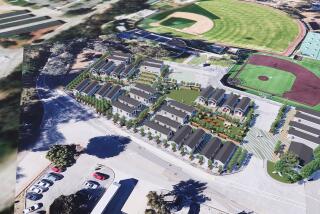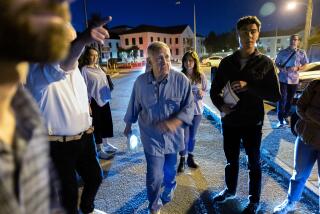Air Force Offered Compromise on Housing at White Point Park
- Share via
SAN PEDRO — Air Force officials are considering a compromise that would allow limited military housing to be constructed along the eastern edge of undeveloped White Point Park in San Pedro while preserving most of the 114-acre property for a new state park.
The compromise, proposed late last week by Los Angeles City Councilwoman Joan Milke Flores, would end a longstanding dispute between Air Force officials, who have sought to construct 170 officers’ homes on the site, and homeowners, environmental groups and Los Angeles officials, who have tried to preserve the one-time Nike missile site as park land.
As part of the plan, the Air Force would be allowed to build housing on 10 acres at White Point as well as on 22 acres at the Martin J. Bogdanovich Recreation Center, a city-owned park a few blocks away. In exchange, the city would be granted clear legal title to the remaining 104 acres at White Point, ending the military’s power to reclaim portions of the property.
White Point Park was deeded to the city in 1978 after being declared federal surplus land, but the deed allows the federal government to reclaim the property for the national interest. The park is located on coastal bluffs above Paseo del Mar, east of Western Avenue.
Favorable Reactions
Flores, who said her plan is the city’s first offer to surrender part of White Point Park, said she has received favorable initial reactions to the proposal from homeowners and from James E. Boatright, a deputy assistant secretary of the Air Force, who discussed the plan with her on Friday.
Air Force spokesman Larry Hannon said on Tuesday that federal officials would carefully evaluate the plan in coming weeks. The Air Force’s acceptance of the proposal will depend on whether the available acreage can accommodate the 170 homes the military expects to build, Hannon said.
Originally, the Air Force sought to reclaim 50 acres of White Point. The current plan would give the Air Force 32 acres, and some of that may be unsuitable for construction because of the hilly coastal terrain at Bogdanovich park, Hannon said.
“Let’s say we have 18 acres of usable land at Bogdanovich and 10 acres at White Point,” he said. “That’s 28 acres . . . a far cry from 50. Until we do a survey, we cannot determine if the amount of land will be adequate nor if the land itself is buildable.”
No Survey Allowed
Hannon said he is not sure when the Air Force will be able to survey the property. So far, the city has refused to allow federal officials access to the property to conduct the surveys, creating a stalemate that now stands before a U.S. District Court judge. The city has been given until Sept. 9 to show why federal surveyors should be excluded from the property.
As part of Flores’ plan, the city would allow federal crews to survey 20 acres on the east edge of White Point, from which the military could select the 10 acres most suited to housing. Hannon said the Air Force still hopes to survey the entire property, saying the 20 acres offered by the city may or may not be usable.
But Hannon characterized last week’s discussions as “amicable” and said the Air Force may be willing to abandon original plans to build only single-family homes on the property. He said military officials could build a combination of single-family homes and town houses to squeeze the housing onto less property.
Turning Point for Park
Ken Malloy, vice president of the San Pedro Homeowners Coalition and national director of the Izaak Walton League, an environmental preservation group, said a settlement of the dispute would represent a turning point in the eight-year effort to create a state park. Development of the park has been delayed because of the federal government’s threat to reclaim the land, Malloy said.
“We would . . . love to have all 114 acres” at White Point, he said. But 104 acres would be enough to establish the park without risking the loss of more land in a court battle with the Air Force, he said.
Allen Ulm, a deputy regional director for the state Department of Parks and Recreation, said the state will not spend money to develop White Point Park until the military housing dispute is resolved. The state will forgo plans for the park if the Air Force reclaims the 50 acres it has requested, Ulm said, but the compromise could make the project possible.
“It depends on what acreage” the Air Force takes, Ulm said. “If they take a narrow strip along the boundary, we may be able to accept it. If they take a block (of land) that sticks out into the park, we may not.”
More to Read
Sign up for Essential California
The most important California stories and recommendations in your inbox every morning.
You may occasionally receive promotional content from the Los Angeles Times.










